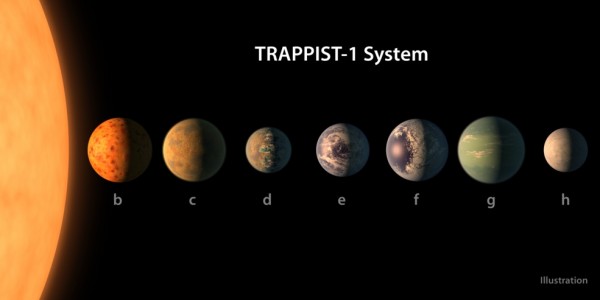By Ana Verayo, | February 25, 2017

This artist's concept shows what each of the TRAPPIST-1 planets may look like, based on available data about their sizes, masses and orbital distances. (NASA/JPL-Caltech)
NASA recently announced an amazing discovery of seven Earth-like planets that can potentially hold life called the TRAPPIST-1 system. However, can these alien worlds really host life and sustain it like Earth? What is life like on these exoplanets?
Like an epic scene from a science fiction movie, sky views from an exoplanet in TRAPPIST-1 will reveal six looming planets. Some may also appear two times bigger than a full moon. According to astronomer Michaël Gillon of the University of Liège in Belgium, if you were on the surface of one of these worlds, you would see an amazing view of the other exoplanets. They would not appear far like Venus or Mars but more similar like how we see the full moon.
Like Us on Facebook
NASA revealed that all of the known TRAPPIST-1 planets orbit closer to their host star than Mercury orbits the sun. The closest and the farthest planets in this system are closer than the farthest distance between Earth and Venus.
These are very tight orbital positions which may lead us to assume that these planets could be destroyed with radiation and reeled in by the gravitational forces their sun. However, TRAPPIST-1 planets orbit an ultracool dwarf star which is 2,000 times less brighter than our sun and is only slightly bigger than Jupiter.
There are also three planets in the system that are located in the "habitable zone". This zone is an ideal orbital position in a stellar system that is not too far or near their star for liquid water to exist and life to flourish.
However, for TRAPPIST-1, the habitable zones are different since it is a very dim star and emits less heat than our sun, making the habitable zone closer to their star. To date, it is still not confirmed if the planets in the habitable zone of TRAPPIST-1 can host flowing water on its surface. For water to be sustained, a planet should possess an atmosphere or else water ice transforms directly into gas and can escape quickly into space.
One of the most unique qualities of these exoplanets is its natural lighting. Even if these worlds orbit so close in proximity to their star, the light would be still very dim to human eyes. Stars classified as ultracool dwarfs emit significantly less radiation than stars similar to our sun.
TRAPPIST-1's light is radiated via infrared wavelengths than visible wavelengths says Amaury Triaud from the Institute of Astronomy of the University of Cambridge. This means that there is warm air on the surface of the seven planets but it will never be as bright as Earths' skies, but more like salmon colored light.
Apart from its dim, salmon skies, six of these planets take anywhere from 1.5 days to 12.4 days to complete a single orbit around their star. The most distant planet is estimated to be 20 days. One year for these planets is apparently less than two weeks on Earth.
Ultimately, even if years are short in any TRAPPIST-1 planet, the days can last very long and can remain eternal since it is highly likely that these planets are tidally locked to their star. This means that only one side of the planet is facing their sun, unlike Earth that rotates around its axis, resulting in days and nights.
Scientists say that this tidally locked side of a TRAPPIST-1 planet is uninhabitable since it can be scorching hot while the night side will be extremely cold.
-
Use of Coronavirus Pandemic Drones Raises Privacy Concerns: Drones Spread Fear, Local Officials Say

-
Coronavirus Hampers The Delivery Of Lockheed Martin F-35 Stealth Fighters For 2020

-
Instagram Speeds Up Plans to Add Account Memorialization Feature Due to COVID-19 Deaths

-
NASA: Perseverance Plans to Bring 'Mars Rock' to Earth in 2031

-
600 Dead And 3,000 In The Hospital as Iranians Believed Drinking High-Concentrations of Alcohol Can Cure The Coronavirus

-
600 Dead And 3,000 In The Hospital as Iranians Believed Drinking High-Concentrations of Alcohol Can Cure The Coronavirus

-
COVID-19: Doctors, Nurses Use Virtual Reality to Learn New Skills in Treating Coronavirus Patients







